The U.S. Supreme Court heard testimony on from Apple, Samsung, and the Department of Justice on Tuesday on how damages should be calculated in design-related patent infringement cases. The hearing is the latest round in the mobile device patent infringement fight the two companies started in 2011, and underscores how confusing it can be to set damages values.

The 2011 case pitted Apple and Samsung against each other over claims they were copying each other’s smartphone patents without proper licensing. A Federal jury ultimately ruled Apple wasn’t infringing on Samsung’s patents, while Samsung infringed on several of Apple’s.
Apple was awarded over US$900 million in damages based on profits for the infringing devices. Samsung eventually negotiated that down to $548 million with a big string attached: if the damages ruling is overturned, it gets the money back with interest.
Samsung argued today that damges should be calculated only on the component parts directly related to the infringing patents. Apple argued consumers buy their smartphones based on the whole package and not individual components, and as such that’s how damages should be determined.
The DOJ took the middle ground saying there should be a sliding scale for courts to use as a guideline. When the overall design is more important, the damages will reflect that; when it’s the components that matter, damages will be based on those parts.
The Justices had plenty of questions for both sides, according to Buzzfeed, and tried using the Volkswagon Beatle as an analogy. The question they debated was how important a roll the car’s design plays in consumer’s decision to buy, and is its physical appearance a key factor.
Samsung also argued the lower court jury should’ve been instructed to calculate damages based on individual components—something the Justices felt would be very confusing. Justice Anthony Kennedy drove that point home saying, “If I was a juror, I simply wouldn’t know what to do.”
And there’s the rub: How do you explain the procedure for calculating design patent damages to a jury without making it overly complicated?
Technology companies are following the case closely because the Supreme Court’s decision will have a real impact on how future design patent cases are handled. That ruling will come in June 2017, so we still have several months to wait before we know which side gets to celebrate.
A minor typo – fifth paragraph down, second sentence, after the graphic: sentence says, “The question they debated was how important a roll ….” sb: “… how important a role….” Probably autocorrect.
🙂
Company Apple no one will catch)